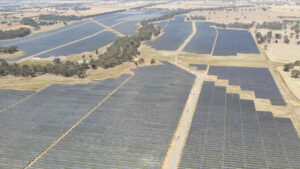Australian steel manufacturer Molycop will begin using recycled rubber from used tyres, conveyer belts and rubber safety boots as feedstock for the production of steel at its electric arc furnace (EAF) in Newcastle.
The steel industry contributes a quarter of global industrial emissions of CO2 and six to nine per cent of total global emissions. Steelmaking is so energy intensive because high levels of heat are needed to melt the ore, usually derived from the burning of coke, a by-product of coal.
EAFs are a relatively new type of steelmaking furnace powered by electricity, and now make up about a quarter of all steelmaking around the globe. EAFs are about 75% less emissions intensive than typical blast furnaces because they require fewer inputs of coke. Nonetheless, EAFs still require the input and burning of carbon-based materials.
Molycop is based in the Newcastle suburb of Waratah and manufactures over 240,000 tonnes of steel each year, including the production of train wheels.
The company has helped to develop the new steel manufacturing process alongside the UNSW SMaRT Centre, footwear manufacturer Crawford Boots, and the Advanced Manufacturing Growth Centre (AMGC).
The new process uses waste rubber from end-of-life vehicle tyres, conveyor belts, and rubber safety boots as a substitute for carbon-heavy feedstock in the company’s Newcastle furnace.
Put simply, the new process maximises the use of rubber crumb (polymer) as a source of the carbon and hydrogen necessary to make steel.
This process is less emissions intensive because while traditional feedstock contains carbon and ash and no hydrogen, rubber tyres contain carbon, roughly eight per cent hydrogen and a lower level of ash. Because hydrogen is a very efficient reducing agent, less carbon is emitted when the rubber burns.
The process will reduce Molycop’s reliance on imported feedstock by up to 20%, could remove up to 90,000 tyres from landfill, and reduce the steelmaker’s electricity consumption and scope one carbon emissions.
“We are investing in innovative solutions that improve the ways we reduce the consumption of virgin raw materials, recover valuable materials from waste streams, minimise waste and reduce our carbon footprint,” said Ian Tooze, Molycop’s president of sustainability.
“What we have developed is yielding results and delivering outcomes for Molycop, our customers and communities in which we operate.”
“This project proves that Australia can develop and, critically, commercialise new and innovative ways to address waste and emissions that also benefits steelmakers’ bottom lines and the environment.
“Through AMGC we have bridged that commercialisation gap, developing a product, process and system that can now be offered to global EAF steelmakers.”
Director of the UNSW Sustainable Materials Research and Technology (SMaRT) Centre, Professor Veena Sahajwalla, said it is crucial for manufacturers and researchers to work to tackle environmental issues, while delivering commercial outcomes.
“Climate change and clean energy narratives often overlook the need for more sustainable manufacturing and waste management practices, where we start to use waste resources for future manufacturing needs,” she said. “Natural resources alone will not deliver the feedstock supply for all of society’s needs, so we need a far more sustainable approach, like some of the innovative recycling technologies we’ve developed at the UNSW SMaRT Centre.
“By working collaboratively with Molycop we have been able to prove that polymer injection works and is commercially viable. It is only through partnerships like this that we can truly achieve positive environmental outcomes at scale.
“I encourage all manufacturers to engage with your local research institution and challenge them with a business issue that needs solving. Conversely, I recommend researchers go out into the field and work with industry because there are really interesting, practical challenges to solve.”










